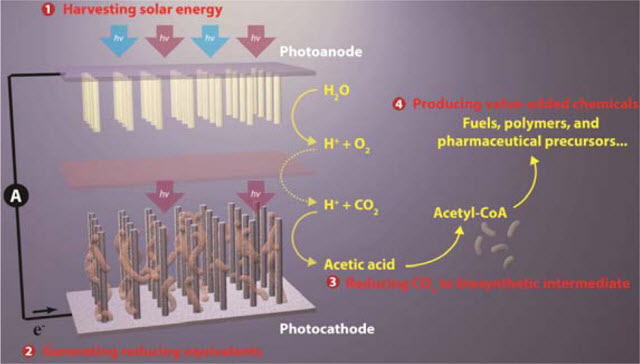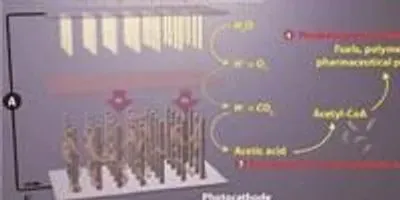 The raw materials for everyday products could someday be produced by bacteria and solar energy.Image courtesy of the American Chemical SocietyIn the American Chemical Society journal Nano Letters, they describe a novel system that converts light and carbon dioxide into building blocks for plastics, pharmaceuticals and fuels — all without electricity.
The raw materials for everyday products could someday be produced by bacteria and solar energy.Image courtesy of the American Chemical SocietyIn the American Chemical Society journal Nano Letters, they describe a novel system that converts light and carbon dioxide into building blocks for plastics, pharmaceuticals and fuels — all without electricity.
Peidong Yang, Michelle C. Y. Chang, Christopher J. Chang and colleagues note that plants use photosynthesis to convert sunlight, water and carbon dioxide to make their own fuel in the form of carbohydrates. Globally, this natural process harvests 130 Terawatts of solar energy. If scientists could figure out how to harness just a fraction of that amount to make fuels and power industrial processes, they could dramatically cut our reliance on fossil fuels. So, Yang, Michelle Chang and Christopher Chang's teams wanted to contribute to these efforts.
The groups developed a stand-alone, nanowire array that captures light and with the help of bacteria, converts carbon dioxide into acetate. The bacteria directly interact with light-absorbing materials, which the researchers say is the first example of "microbial photoelectrosynthesis." Another kind of bacteria then transforms the acetate into chemical precursors that can be used to make a wide range of everyday products from antibiotics to paints.
The authors acknowledge funding from the U.S. Department of Energy, the Lawrence Berkeley National Laboratory, Howard Hughes Medical Institute, the National Science Foundation and the National Institutes of Health.
In the American Chemical Society journal Nano Letters, they describe a novel system that converts light and carbon dioxide into building blocks for plastics, pharmaceuticals and fuels — all without electricity.
To continue reading this article, sign up for FREE to

Membership is FREE and provides you with instant access to eNewsletters, digital publications, article archives, and more.


